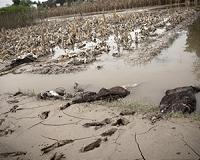 |
Montreal, Canada (SPX) Feb 08, 2011 A growing global population has lead to increasing demands for food. Farmers around the world rely, at least in part on phosphorus-based fertilizers in order to sustain and improve crop yields. But the overuse of phosphorus can lead to freshwater pollution and the development of a host of problems, such as the spread of blue-green algae in lakes and the growth of coastal 'dead zones'. A further issue is that phosphorus comes from phosphate rock, a non-renewable resource of which there are limited supplies in such geopolitically charged areas as Western Sahara and China. Now, for the first time ever, a detailed global map has been produced showing imbalances in the way that phosphorus, an essential plant nutrient, is being used around the world. "Typically, people either worry about what happens when an excess of phosphorus finds its way into the water, or they focus on what happens when we run out of phosphorus," says Graham MacDonald, a PhD student in the Department of Natural Resource Sciences at McGill University, who led the study. "This is the first study that illuminates the issue on a global scale and suggests that these are not separate problems ... that the issue is one of distributing the phosphorus we've got." The study used detailed agronomic information about how much phosphorus is applied to soils in fertilizers and manures for more than 100 different food, feed, and fibre crops produced around the world in 2000. The results point to large imbalances in phosphorus use, with both the overuse of phosphorus in some parts of the world and phosphorus deficits in others. There were some surprising findings. While it is typically assumed that phosphorus deficits exist in only the poorer countries in sub-Saharan Africa, and phosphorus surpluses dominate in the wealthy nations of Europe and North America, in fact phosphorus levels vary widely within most nations - with surpluses and deficits commonly occurring side-by-side in a single region. Furthermore, countries such as Ukraine, long-known as the Russian empire's 'bread basket', is one area that now suffers from phosphorus deficits, while eastern China and southern Brazil have been identified as phosphorus 'hotspots', where surplus phosphorus from the intensive use of fertilizers pose a danger of being lost from farmlands in runoff where it may pollute freshwater supplies. "Until you can quantify how phosphorus is actually currently being used," MacDonald says, "it's difficult for policy-makers to go ahead and make informed decisions at a national or global scale." Now they will have a tool to help them do so.
Share This Article With Planet Earth
Related Links McGill University Farming Today - Suppliers and Technology
 Southern Africa floods threaten more crops
Southern Africa floods threaten more cropsRome (AFP) Feb 7, 2011 Floods and heavy rain across southern Africa have damaged thousands of hectares (acres) of farmland and more may be hit in coming weeks, raising fears for food supplies, the UN food agency said Monday. With the rainy season still only half way through, and with the cyclone season due to peak in February, agricultural areas along the region's rivers in remain at high risk of flooding, the Foo ... read more |
|
| The content herein, unless otherwise known to be public domain, are Copyright 1995-2010 - SpaceDaily. AFP and UPI Wire Stories are copyright Agence France-Presse and United Press International. ESA Portal Reports are copyright European Space Agency. All NASA sourced material is public domain. Additional copyrights may apply in whole or part to other bona fide parties. Advertising does not imply endorsement,agreement or approval of any opinions, statements or information provided by SpaceDaily on any Web page published or hosted by SpaceDaily. Privacy Statement |